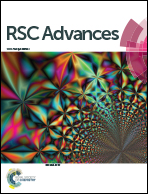Enhanced charge storage of Li3FeF6 with carbon nanotubes for lithium-ion batteries†
Abstract
Due to stability in the air, easy preparation process, lower cost and high reaction potential, Li3FeF6 is a promising cathodic material in lithium-ion batteries. However, the poor electronic conductivity of Li3FeF6 limits its performance in lithium-ion batteries. Conductive agent addition can improve the electronic conductivity of Li3FeF6 composite electrodes. The specific capacity of the Li3FeF6/C electrode is around 80 mA h g−1 (the highest value), corresponding to 0.57 Li+ embedding. While a specific capacity of the Li3FeF6/CNTs electrode of 120 mA h g−1 can be achieved, which is close to the theoretical capacity (140 mA h g−1), and the reversible capacity can be maintained at above 100 mA h g−1 after 50 cycles, with a capacity retention of 83%, which indicates greater electrochemical activity for such a CNT containing electrode. The enhanced performance of the Li3FeF6/CNTs electrode is due to the lower interface resistance and improved electrochemical activity of the Li3FeF6 active material.


 Please wait while we load your content...
Please wait while we load your content...